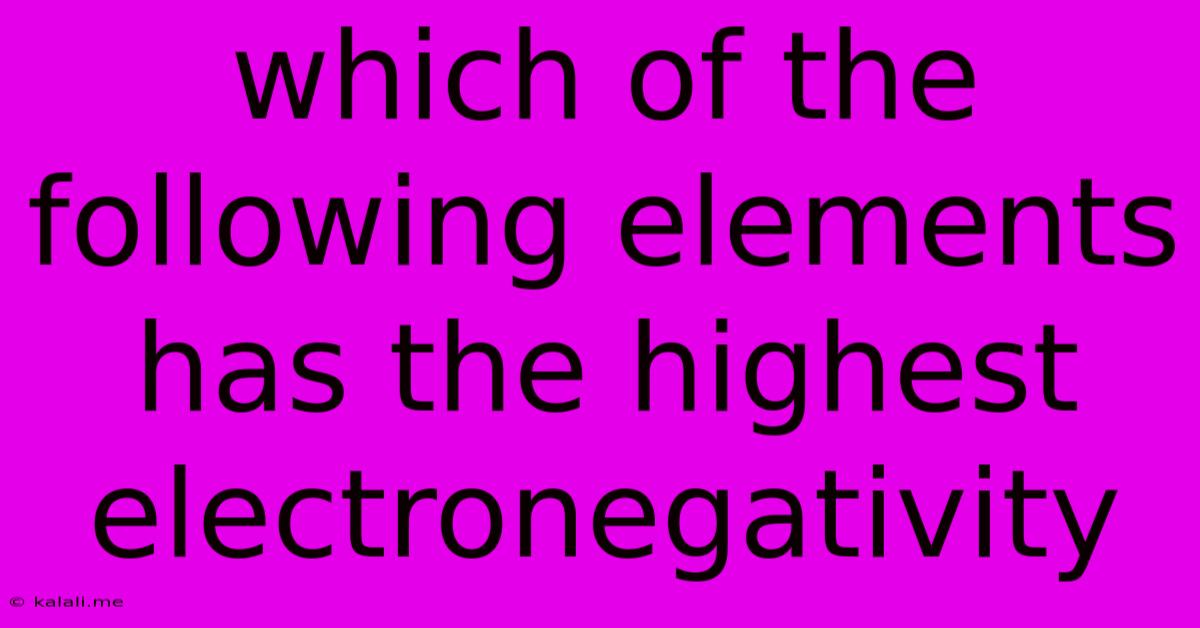Which Of The Following Elements Has The Highest Electronegativity
Kalali
Jun 13, 2025 · 2 min read

Table of Contents
Which Element Boasts the Highest Electronegativity? Unveiling the Champion
Electronegativity, a crucial concept in chemistry, measures an atom's tendency to attract electrons towards itself within a chemical bond. Understanding electronegativity is key to predicting the behavior of molecules and their reactivity. But which element reigns supreme in this electron-grabbing competition? This article delves into the fascinating world of electronegativity, explaining its trends and ultimately revealing the element with the highest electronegativity.
What is Electronegativity and Why Does It Matter?
Electronegativity isn't a directly measurable quantity like mass or weight. Instead, it's a relative property, often represented on the Pauling scale, where values range from approximately 0.7 to 4.0. Higher electronegativity values indicate a stronger pull on electrons. This difference in electronegativity between atoms within a molecule dictates the type of bond formed – ionic (large difference), covalent (small difference), or somewhere in between (polar covalent). Understanding bond polarity is critical for predicting molecular properties like polarity, boiling point, and reactivity. Factors influencing electronegativity include the atom's nuclear charge, atomic radius, and shielding effect from inner electrons.
Periodic Trends in Electronegativity: A Journey Across the Table
Electronegativity exhibits clear trends across the periodic table. Generally:
- Increases across a period (left to right): As you move across a period, the number of protons in the nucleus increases, increasing the positive charge attracting electrons. The atomic radius generally decreases, leading to a stronger pull on bonding electrons.
- Decreases down a group (top to bottom): As you go down a group, the number of electron shells increases, leading to increased shielding of the outer electrons from the nucleus. The atomic radius also increases, resulting in a weaker attraction to bonding electrons.
The Electronegativity Champion: Fluorine's Reign
Considering the periodic trends, it's no surprise that the element with the highest electronegativity resides in the upper right-hand corner of the periodic table. That element is Fluorine (F), with an electronegativity value of approximately 4.0 on the Pauling scale. Its small atomic radius and high effective nuclear charge (due to its seven valence electrons) combine to create an exceptionally strong pull on shared electrons in a chemical bond.
Other Highly Electronegative Elements:
While fluorine holds the top spot, several other elements exhibit high electronegativity:
- Oxygen (O): A crucial element in many biological and chemical processes, oxygen has a relatively high electronegativity, second only to fluorine.
- Nitrogen (N): Another important element in biological systems, nitrogen possesses a strong pull on electrons, resulting in its participation in numerous covalent bonds.
- Chlorine (Cl): A halogen like fluorine, chlorine displays high electronegativity, although less than fluorine.
Understanding the relative electronegativity of elements is essential for predicting the behavior of molecules and chemical reactions. Fluorine's claim to fame as the most electronegative element underlines the importance of its position and properties within the periodic table. Knowing this key concept helps unravel the intricate dynamics of the chemical world.
Latest Posts
Latest Posts
-
How Fast Does A Peacock Run
Jun 14, 2025
-
Which Of These Lines Is A Metaphor
Jun 14, 2025
-
Difference Between Quality Control And Quality Assurance Pdf
Jun 14, 2025
-
Gpa Requirements For University Of Memphis
Jun 14, 2025
-
What Are The Prime Factors Of 156
Jun 14, 2025
Related Post
Thank you for visiting our website which covers about Which Of The Following Elements Has The Highest Electronegativity . We hope the information provided has been useful to you. Feel free to contact us if you have any questions or need further assistance. See you next time and don't miss to bookmark.